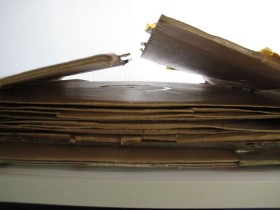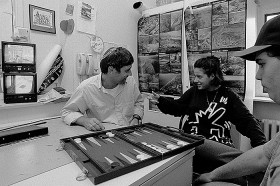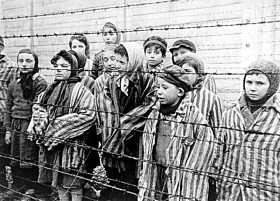There are films slumbering in an archive somewhere, waiting to be discovered. And there are films that have sunk into oblivion but then suddenly pop up again, in the form of a soundtrack.

The schellac records, as found © Jewish Museum Berlin, Photo: Regina Wellen
Recently, when stock was being moved to another depot, our colleague Regina Wellen looked over the collection of 78rpm schellac records with a view to devising a new way of storing them. She thereby came across eleven not yet inventoried records, much larger than the usual sort and with a label suggestive of some other purpose than easy listening on the home gramophone. Luckily for us, Regina was quickly able to establish that these were examples of the sound-on-disc recordings played in cinemas as an accompaniment to screenings of otherwise silent films—synchronously, thanks to the built-in start signal. One of the twenty numbered boxes on each label used to be checked after each screening, so as to ensure that a worn-out record would be replaced in good time. After Regina had dry-cleaned the records and prepared → continue reading
Complementing our special exhibit, “Snip It! Stances on ritual circumcision”, our blogger team went looking for Jews and Muslims who could speak on the topic from a very personal perspective, whether for or against circumcising their sons. We called upon our networks of friends and acquaintances and received a range of responses in return. Some made us smile; others, like this one about David, gave us pause. It is retold to us by Shlomit Tulgan, our colleague in the education department who knows him from childhood:

Shlomit met David in the Jewish Culture Center in Berlin
On this photo you see a tutor of the Berlin Jewish Community’s youth center on Joachimstalerstr playing Backgammon with kids, Berlin 1992 © Photo: Michael Kerstgens, Jewish Museum Berlin
David was born to a secular Jewish mother and, at 22, chose to be circumcised in Berlin’s Jewish Hospital. His reason was to “get back to his roots and regain what his parents had denied him.” David was no “sad child,” remembers Shlomit, who met him most of all at the Berlin Jewish Community’s youth center on Joachimstalerstr. Seemingly every month he was in love with another Jewish girl, and he was popular among the opposite sex despite his nature to move swiftly from one to the next. The youth center was particularly supportive when the circumcision was performed. Recovering in a hospital bed, David’s Lebanese flatmate and friend → continue reading

Surviving children in the main concentration camp, Auschwitz. This still from documentary footage shot by Alexander Voronzow shows Tomasz Szwarz, Alicja Gruenbaum, Solomon Rozalin, Gita Sztrauss, Wiera Sadler, Marta Wiess, Boro Eksztein, Josef Rozenwaser, Rafael Szlezinger, Gabriel Nejman, Gugiel Appelbaum, Mark Berkowitz, Pesa Balter, Rut Muszkies, Miriam Friedman, and Miriam and Eva Mozes. Licensed for the public domain by the United States Holocaust Memorial Museum.
Seventy years ago to this day, the Soviet Army liberated the death camps Auschwitz I and II. Almost ten years ago, the anniversary was designated International Holocaust Remembrance Day. Although I’ve been reflecting on representations of the Holocaust in art, literature, and philosophy for many years, I remain irritatingly little affected by today’s date, January 27. In most European countries, official events will once again collectively recall that breach of civilization and commemorate those who were systematically murdered. So too will Germany. Here, the decision to officially commemorate the victims of the Holocaust on this day was reached in 1996—not least because → continue reading


